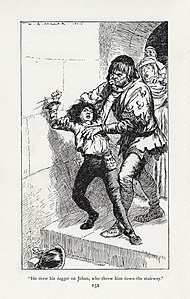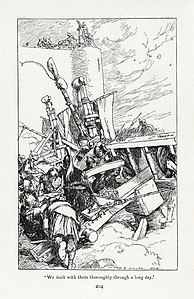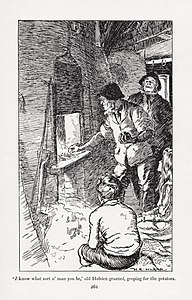H. R. Millar
- Harold Millar redirects here. For those of a similar name, see Harold Miller (disambiguation)
H. R. Millar | |
|---|---|
| Born | Harold Robert Millar 1869 Dumfries, Dumfriesshire, Scotland |
| Died | 1940 |
| Nationality | Scottish |
| Known for | Children's Literature |

Harold Robert Millar (1869 – 1940) was a prominent and prolific Scottish graphic artist and illustrator of the late nineteenth and early twentieth centuries. He is best known for his illustrations of children's books and fantasy literature.[1] "His work...has a lively, imaginative charm and a distinctive sense of design."[2]
A native of Dumfriesshire, Millar first pursued civil engineering before deciding upon an artistic career. He then studied at the Wolverhampton Art School and the Birmingham School of Art, and established his career as a magazine illustrator with Punch, Good Words, and other periodicals of the day.
Millar illustrated fables for the Strand Magazine, and anthologies of tales, The Golden Fairy Book, The Silver Fairy Book, The Diamond Fairy Book, and The Ruby Fairy Book. He illustrated books by a wide range of British authors of his time, including Sir Arthur Quiller-Couch, Robert Louis Stevenson, and Rudyard Kipling. He had an extensive working relationship with E. Nesbit, and has been called "the most sympathetic and perhaps the most talented of her illustrators."[3]
Apart from fantasy and children's books, Millar drew pictures for works like Kate Lawson's Highways and Homes of Japan (1910) and Arthur Radclyffe Dugmore's African Jungle Life (1928). Millar was a noted collector of Eastern art and exotic and ancient weapons, and employed his interest and knowledge in these areas in his artwork.
A partial list of the books Millar illustrated includes:
- George Eliot's Scenes of Clerical Life
- H. Rider Haggard's The Brethren
- Newman Harding's The Little Black Monkey and The Little Grey Pedlar
- Nathaniel Hawthorne's Tanglewood Tales
- Howard Angus Kennedy's The New World Fairy Book and The Canadian Fairy Book
- Kipling's Kim and Puck of Pook's Hill
- Captain Marryat's Frank Mildmay, The Phantom Ship, and Snarley-Yow
- Mrs. Molesworth's Peterkin
- James Morier's The Adventures of Hajji Baba of Ispahan
- Edith Nesbit's The Book of Dragons, The Enchanted Castle, Five Children and It, The House of Arden, The Magic City, The Phoenix and the Carpet, The Story of the Amulet, and other works
- Thomas Love Peacock's Headlong Hall and Nightmare Abbey
- Quiller-Couch's Fairy Tales Far and Near
- Tetta Ward's My Fairy Tale Book
— among various others.
Illustrations to Puck of Pook's Hill (1906)
-
Frontispiece: They saw a small, brown ... pointy-eared person ... step quietly into the Ring
-
Weland's Sword: Then he made a sword
-
Young Men at the Manor: 'At this she cried that I was a Norman thief'
-
Young Men at the Manor: Said he, 'I have it all from the child here'
-
Young Men at the Manor: 'Sir Richard, will it please you enter your Great Hall?'
-
The Knights of the Joyous Venture: 'And we two tumbled aboard the Dane'
-
The Knights of the Joyous Venture: Thorkild had given back before his Devil, till the bowmen on the ship could shoot it all full of arrows
-
The Knights of the Joyous Venture: 'So we called no more'
-
Old Men at Pevensey: 'A' God's Name write her free, before she deafens me!'
-
Old Men at Pevensey: He drew his dagger on Jehan, who threw him down the stairway
-
A Centurion of the Thirtieth: 'You put the bullet into that loop'
-
On the Great Wall: 'And that is the Wall!'
-
The Winged Hats: 'Hail, Caesar!'
-
The Winged Hats: 'We dealt with them thoroughly through a long day'
-
The Winged Hats: 'The Wall must be won at a price'
-
The Winged Hats: Where they had suffered most, there they charged in most hotly
-
Hal o' the Draft: 'I reckon you'll find her middlin' heavy,' he says
-
'Dymchurch Flit': 'I know what sort o' man you be,' old Hobden grunted, groping for the potatoes
-
The Treasure and the Law: Doors shut, candles lir
-
The Treasure and the Law: 'They drove me across the drawbridge'
References
- ^ Stephen Pickett, Victorian Fantasy, second edition, Waco, TX, Baylor University Press, 2005; p. xi and ff.
- ^ John Clute and John Grant, The Encyclopedia of Fantasy, New York, Macmillan, 1999; p. 646.
- ^ Marcus Crouch, Treasure Seekers and Borrowers: Children's Books in Britain, 1900–1960, London, The Library Association, 1962; p. 15.




















